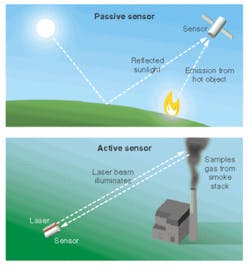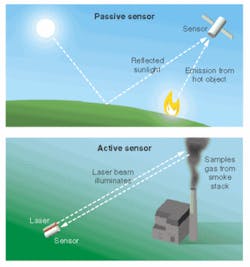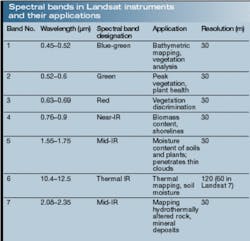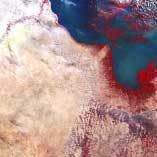Ever vigilant, optical sensors already monitor much of our daily lives
Novel deployment methods and new ways of combining and processing data from multiple devices will make optical sensing even more ubiquitous than it is today.
Optical remote sensing involves sensing at a distance using either passive or active optical techniques. Sensors can look at a single wavelength, at a broad range of wavelengths, or at a number of wavelengths in the infrared, visible, or the ultraviolet. Sensor output can be processed in various ways to generate images, to identify the characteristic signatures of materials, or for other purposes. Sensors can look at ambient light, or rely on active illumination of the scene by lasers or other light sources. "Remote" generally means that the sensor is at a distance from the object being studied, but in some cases, a sensor can be placed near the object and then transmit a signal to remote instruments, such as a hidden microphone.
The March 2004 "Back to Basics" feature examined one important type of passive remote sensing: optical surveillance satellites (see Laser Focus World, p. 99). Another recent article described active sensing with laser radar (see Laser Focus World, May 2004, p. 154). This article outlines the basic principles of optical remote sensing and describes important examples and emerging developments.
Passive and active sensing
Passive sensing relies on ambient illumination and light emitted by the object (see Fig. 1). Typically, ambient illumination is sunlight, but sensors also can pick up light from artificial sources or hot objects. For example, early warning satellites look for the hot exhaust from missile engines. Infrared sensors can spot objects that are slightly warmer than ambient temperature by looking at the blackbody radiation they emit. Warmer objects glow brighter, so people and car engines stand out as bright spots. Infrared sensors don't require sunlight, and are often called "night vision" systems.
Active sensing illuminates the object being studied with an external light source to increase sensitivity. In practice, the active probe is chosen to produce a specific response from the target. For instance, illumination with a specific laser wavelength might make a mineral fluorescence at another wavelength; a sensor could spot that mineral by looking for the specific fluorescence. Reflection of brief pulses from laser radars can measure distances to targets or even identify certain gases.
Wavelength bands
The choice of wavelengths depends on the type of sensing. Except for short-distance applications, atmospheric transmission is always critical. So is the response of the desired material. Searching for specific materials may require the use of specific wavelengths, but care must be taken to avoid interference from other materials that are likely to be in the same field of view. If you're looking for geese on a golf course, you don't want an infrared wavelength that is strongly reflected by grass and feathers.
Common bands used for remote sensing include:
- near-UV—transmitted reasonably by air, stimulates fluorescence;
- visible—for imaging and fluorescence;
- near-IR—looking for specific reflection and absorption bands, and observing vegetation and moisture;
- mid-IR (3 to 5 µm)—specific reflection and absorption, and thermal emission from hot objects;
- thermal IR (8 to 12 µm)—thermal emission from warm objects, spotting people or animals, night vision without illumination.
Depending on the application, these bands can be broken down into smaller bands to see specific features.
Earth resource satellites
Probably the most well-known family of civilian remote-sensing satellites consists of the Landsat satellites, which scan Earth on several wavelength bands chosen for specific purposes (see table). The data can be expressed in various ways; the most familiar visual representations are false-color images (see Fig. 2).
Landsats have operated continuously since 1972, and that continuity is important for long-term monitoring of vegetation, soil moisture, snow cover, and other climate variables. To ease comparisons, the satellites have flown in similar Sun-synchronous orbits so the area of the Earth's surface that is being scanned is illuminated by the Sun at similar angles. Different bands provide different information on quantities such as vegetation coverage, type of vegetation, and soil moisture. The two currently operational Landsats orbit at an altitude of 705 km, with each scanning the Earth's entire surface in a 16-day series of 233 orbits.
Slicing the spectrum into thinner bands can give more information about surface composition but sacrifices resolution. For example, the thermal emission spectrometer on the Mars Global Surveyor measures intensity on 143 spectral bands between 6.25 and 50 µm. The ground resolution is only 3 km, but the high spectral resolution allows better identification of minerals such as olivine, important in assessing the history of the Martian surface.
Remote chemical sensors
On the ground, remote optical sensors have long been developed for sensing environmental pollutants and toxic agents for civilian and military use. Pollution monitoring spans the range from research to process control and regulatory enforcement. Military and homeland security applications face the same fundamental goal—identification of a toxic agent from a safe distance—but the operational requirements differ greatly from the precise measurement of emissions for verification of regulatory compliance.
The specific design depends on what is being measured and for what purpose. For example, an active sensor with a laser source tuned to one particular absorption line would be fine for measurement of a known compound emitted from a smokestack. However, it would not work for military and security applications, in which a variety of chemical and biological agents are potential hazards. In many cases it's important to identify the compound so appropriate countermeasures can be taken, especially if people have been exposed.
First responders—which in homeland-security jargon can mean everyone from stadium ushers to emergency medical teams—have different requirements. For this group, ideal sensors are inexpensive, simple, robust, easily portable, and easy to use. They also should be able to respond quickly to a broad range of toxic compounds; for example, warning of a potential class of hazard may be more important than knowing exactly what compounds are present, at least until medics arrive and have to select antidotes. One approach to address the needs of first responders would be a multispectral sensor with several passbands that can be integrated to profile the substance's spectral response (see Fig. 3).
At the April SPIE Defense and Security Symposium (Orlando, FL) Stephen K. Holland of the University of Virginia described a sensor that uses an eight-element array of uncooled pyroelectric detectors, equipped with separate filters in the thermal IR. Initial laboratory tests show it could discriminate between methanol and two other organic toxins.
Remote biological sensing is similar to chemical sensing in principle, but a key difference is the high likelihood of false alarms. Optical sensors that essentially respond to overall chemistry can easily miss the subtle differences between harmless bacteria and some deadly pathogens. Other types of sensors also generate false positives for pathogens such as anthrax; the most accurate tests take time that can be ill afforded in case of a biological attack.
Active fluorescence-based sensors are attractive because they can be made specific, but practical short-wavelength laser sources are a problem. The Defense Advanced Research Projects Agency (DARPA) is addressing the light-source problem with a program to develop semiconductor UV sources at a range of wavelengths that could be paired with wavelength-specific fluorescence sensors to filter out potentially confusing background signals. The agency hopes to produce optical biosensors that can identify pathogens quickly and accurately.
Pushing the technological envelope
The Pentagon and the Department of Homeland Security are trying to extend the state of the art, both in specific sensing systems and in sensors and related technologies. For example, developers are trying to enhance the sensitivity of optical chemical sensors so they can identify traces of explosive vapors to spot hidden bombs or land mines.
Under study are new ways of deploying sensors, such as making small sensors ubiquitous in the environment. They would have much smaller ranges than conventional remote sensors but would have a more pervasive presence. For example, in "smart dust," tiny sensors would include simple on-board processors that broadcast data to nearby receivers for further processing and integration.
Signal processing and the integration of data from many distributed sensors also are important issues. "Sensor fusion" seeks to integrate information gathered from many sensors to figure out what's going on, much as we analyze input from our senses. Developers hope that correlating input from multiple sensors can tell us more than individual sensors, just as we might pick up hints that something was wrong with our car from an odd noise and a peculiar smell. This can be difficult in practice, but the goal is to take advantage of information collected from many sources.
DARPA is looking at exploiting emerging sensing techniques to identify and track potential targets on the battlefield. One example is the collection of three-dimensional data with laser radars that can reach through holes in the forest canopy, and manipulating that data to view objects from other perspectives and identify enemy targets. Another example is the collection, correlation, and processing of images collected by unmanned aerial vehicles flying above the battlefield. Thomas M. Strat of DARPA envisions a future battlefield with "droves of UAVs bristling with sensors," able to watch everything that moves. Current staff and systems couldn't cope with the flood of image data, but Strat suggests that new processing technology could handle the load by tracking individual targets continually, rather than searching for them again and again.
We're still a long way from the kind of pervasive sensing that DARPA programs are trying to create. Yet whether those goals are achievable, remote optical sensing has come a long way. In the civilian world, weather forecasting and climate-change research depend heavily on it. In the military and security worlds, remote sensing serves as a force multiplier and extra sets of untiring watchful eyes. In those ways, remote sensing is already pervasive.




